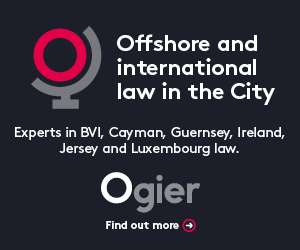
Securitisation and Cayman Orphan SPVs – Part Two
In the second in a series of three articles, Paul Trewartha and Simon Lawrenson, Partners at Mourant Hong Kong, examine the key features of a securitisation vehicle and the advantages of utilising an Orphan SPV in the Cayman Islands for a securitisation transaction.
In the first article, Securitisation and Cayman Orphan SPVs – Part One, we briefly discussed what a securitisation is, the reasons for undertaking such a transaction and the key features and advantages of a Cayman Islands Orphan SPV. This article will focus on the key considerations of a Cayman Islands Orphan SPV as it relates to a securitisation transaction and how to achieve bankruptcy remoteness.
Key considerations of an Orphan SPV Structure
Independence
Securitisation vehicles are structured as Orphan SPVs in the Cayman Islands to, among other reasons, ensure that the issuer is independent and to give best possible assurance that the arranger or other originator cannot exert improper influence over the issuer.
In order to avoid the consolidation of accounts between the Orphan SPV and the arranger in the event of an insolvency, there are other actions and steps that are typically taken to reflect the independent nature of the Orphan SPV, which include the following:
- appointing independent directors based in the Cayman Islands who have no link or nexus to the arranger, are not employees of the arranger and receive no fee or payment from the arranger;
- requiring the independent directors of the Orphan SPV to consider and pass a board resolution in respect of any transactions it proposes to enter into;
- not allowing any of the Orphan SPV’s assets to co-mingle or be pooled with the assets of any other company;
- appointing separate legal counsel to advise the Orphan SPV in all of its dealings with any third party, including those parties to the securitisation;
- not granting any security for the obligations of any other company;
- producing separate accounts which are not consolidated with any other entity;
- holding itself out as having a distinct and independent existence, being able to acquire and hold assets and carry on business in its own name in a manner separate from any other party; and
- maintaining arms-length relationships with other parties to the securitisation whereby any dealings with such other parties are documented on an arms-length basis for proper consideration and in respect of which the directors of the Orphan SPV consider the terms of the securitisation and pass resolutions on the basis that (i) there is genuine corporate benefit to the Orphan SPV and (ii) it is in the best and commercial interests for the Orphan SPV to proceed with the securitisation transaction.
Bankruptcy remoteness
One of the key criteria for an Orphan SPV issuer in a securitisation is to ensure that it is a bankruptcy remote vehicle, particularly in (albeit unique) circumstances where the obligations of the Orphan SPV are not secured against the Underlying Assets.
The purpose of the bankruptcy remoteness structural arrangements is to ensure that the Orphan SPV will not be affected by the insolvency of any of the other securitisation parties, most notably any entity from the arranger or originator group. This is partly achieved through the off-balance sheet treatment discussed in the first article in this series, however, there are two other key critical elements which must be incorporated into the structure, through the terms of the transaction documents, namely:
- limited recourse provisions; and
- non-petition provisions.
These provisions (which are discussed in more detail below) operate to ensure that, where an Orphan SPV is a single-issuer of multiple tranches of Notes (which are supported by security over specified Underlying Assets), the relevant Underlying Assets acquired by the proceeds of a tranche of Notes are effectively ring-fenced from other tranches of Notes issued (if any), or other obligations incurred, by the Orphan SPV and the associated Underlying Assets of such other issuance or incurred obligations.
Accordingly, any claim by a secured creditor of the Notes can only be made against the specific Underlying Assets for that tranche or series of Notes. This is a critical aspect of a securitisation vehicle to ensure that the creditors of a tranche of Notes are not able to bring a claim on the Underlying Assets of another separate tranche or series of Notes issued by the same Orphan SPV, avoiding cross-collateralisation and safeguarding the credit worthiness of the Orphan SPV.
Limited recourse
The terms of each transaction document executed by an Orphan SPV issuer should make it clear that the Orphan SPV issuer enters into such document (and the transaction generally) on the basis that its liability is limited to the proceeds received on the specific Underlying Assets which are held by the Orphan SPV in relation to the Notes issued by the Orphan SPV issuer (namely, the specific Underlying Assets which were acquired with the proceeds of the Notes).
Typically, these limited recourse provisions will be drafted such that the other transaction parties to the securitisation will agree that upon realisation of the Underlying Assets relating to the Notes issued, to the extent there is any shortfall to meet any claim or obligation, any such claim will be extinguished and no other assets of the Orphan SPV shall be available to meet any such shortfall.
This means that any such shortfall will be borne by the other transaction parties and ensures the integrity and credit worthiness of the Orphan SPV, particularly in relation to any issuer which is a multi-issuance entity and which may hold other assets which have been secured in favour of other tranches or series of Notes. Following enforcement of the security over the relevant Underlying Assets, the securitisation parties will agree that no further action may be taken against the Orphan SPV and that no winding up proceedings may be commenced against it.
Enforceability
While there is no direct judicial authority in the Cayman Islands with respect to such provisions:
- a contractual provision which provided for the extinguishment of a secured debt after exhaustion of the assets on which that debt was secured will be valid, binding and enforceable as a matter of Cayman Islands law (assuming that the provision was valid, binding and enforceable under the law governing the contract in which it was contained); and
- after the extinguishment of the secured debt, the secured creditor would not have standing to make a claim in respect of the debt, whether for its repayment, the winding up of the Orphan SPV or otherwise.
A court of the Cayman Islands would be unlikely to seek to expand the liabilities of the Orphan SPV beyond those assumed by it under each transaction document to which it is party as properly interpreted in accordance with the governing law of that transaction document. If all of those liabilities had been extinguished, no basis would exist for filing a petition to wind up the Orphan SPV with a court of the Cayman Islands.
Upholding non-petition
Similar to the limited recourse provisions referred to above, the transaction parties of the securitisation should all agree under the terms of the relevant transaction documents entered into by the Orphan SPV that they will not take any steps or present any petition against the Orphan SPV for its liquidation.
Enforceability
The advantages of utilising a Cayman Islands incorporated Orphan SPV are again highlighted as this contractually agreed position is expressly recognised by statute in the Cayman Islands pursuant to section 95(2) of the Companies Act (as amended) of the Cayman Islands (the Companies Act) which states that:
The Court shall dismiss a winding up petition or adjourn the hearing of a winding up petition on the ground that the petitioner is contractually bound not to present a petition against the company.
As such, the courts of the Cayman Islands must dismiss a winding up petition against an Orphan SPV, or adjourn any hearing of a winding up petition against such Orphan SPV, if the petitioner has contractually agreed not to present a winding up petition against that Orphan SPV. Accordingly, it is imperative from the perspective of the Orphan SPV that all other transaction parties (typically, each a secured creditor) agree to the terms of the non-petition provision and that the provision is expressed to capture all other transaction parties to the securitisation transaction.
Other steps to ensure bankruptcy remoteness
Other steps which should be taken to ensure the Orphan SPV is a bankruptcy remote vehicle are as follows:
- establishing a new entity with no previous operating history and with a limited number of creditors;
- appointing a director or directors which are independent of the arranger or originator of the Underlying Assets relating to the Notes issued by the Orphan SPV;
- restricting the purpose and activities of the Orphan SPV in the constitutional documents and the securitisation transaction documents (including restrictions on the power of the Orphan SPV shareholders from amending the constitutional documents of the Orphan SPV);
- including debt limitations in the securitisation transaction documents;
- restricting the power of the Orphan SPV shareholders from voluntarily winding up the Orphan SPV; and
- ensuring that the Underlying Assets are transferred from the originator to the Orphan SPV pursuant to a ‘true sale’ (which depends on the situs of the Underlying Assets).
The next article in this series will focus on the administration of an Orphan SPV and the use of Cayman Islands segregated portfolio companies and limited liability companies in a securitisation structure.



